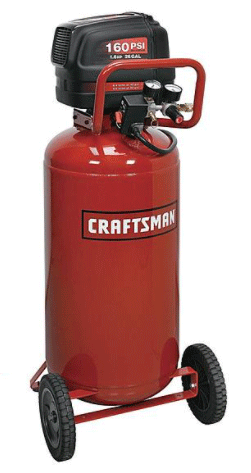Why does a 7 year old Craftsman 26 gallon 1.6 HP 160 PSI air compressor lose about 40 PSI of pressure a day? What can be done about this?
The first thing to be said that a compressor probably shouldn’t be left with pressure in the tank for days and days. Why? There’s water in the tank that develops as the compressor does its job, and that water sits in the lowest part of the tank, the part where the tank drain valve is typically installed. After a while that water can start deteriorating the metal in the tank with long term issues of tank rust through and rupture. Air in the tank for a day or two is OK, but get in the habit of draining the tank completely at least once a week as draining the air from the tank through the tank drain valve will also expel any accumulated water.

Where is the compressor leak coming from?
After the tank is drained, it’s time to find out where the leak is coming from.
Mix up a soap solution, 1 part soap to 10 parts water. Dish soap works well. Let the compressor run up to cut out, and shut off the power.
Soap every joint on the compressor that you can find. You might even pull any intake filter if there is one and carefully soap over the intake port to see if a bubble forms. Remove the soap solution before the intake filter is reinstalled.
Any leaks?
Tank check valve
If there are no leaks to be found anywhere on the compressor, then it’s time to consider that the tank check valve is leaking.
The tank check valve is supposed to keep air in the tank after the compressor stops. With no check valve, already compressed air would stream back up the line and out the unloader valve which is always open when the compressor is off.
Over time the check ball or flap in the check valve, or the place on which it sits, can become “crudded” up, and may prevent the ball or flap from sealing tightly enough to keep air in the tank.
The tank check valve is typically located where the line from the pump head enters the tank. There are many configurations of tank check valves, but essentially they have the line coming from the pump to the tank, and may have another small line teed off that runs over to the unloader valve on the pressure switch.
Regardless, empty the tank completely with the power off. Disconnect the line(s) from the tank check valve and unthread the valve from the tank. Basically the check valve should only allow air to flow in one direction. Give it a good rinse in very hot water, and test the check valve.
If air flows both ways through the valve, even if it’s a limited flow in one direction, the check valve has failed and needs to be replaced.
Comments or questions? Please post them below.


